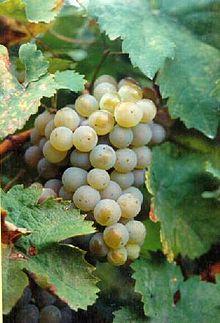Liebfraumilch or Liebfrauenmilch (German for 'Beloved lady's milk', in reference to the Virgin Mary) is a style of semi-sweet white German wine which may be produced, mostly for export, in the regions Rheinhessen, Palatinate, Rheingau, and Nahe. The original German spelling of the word is Liebfrauenmilch, given to the wine produced from the vineyards of the Liebfrauenkirche or "Church of Our Lady" in the Rhineland-Palatinate city of Worms[1] since the eighteenth century. The spelling Liebfraumilch is more common on labels of exported wine.[2]
Classification
The generic label Liebfraumilch is typically used to market vintages from anywhere in most of the major wine growing areas of Germany, the notable exception being Mosel. Wine with very similar characteristics but made from higher quality grapes can be labeled as Spätlese or Auslese. In the U.S. and the UK, perhaps the best known example has been Blue Nun, which no longer uses the Liebfraumilch designation.
The term Liebfraumilch is associated with low quality wine, and, consequently, the German wine classification requires it only to be at the Qualitätswein bestimmter Anbaugebiete (QbA) level—the third rank out of ten. However, it must also be from Rheinhessen, Pfalz, Nahe, or Rheingau, and the grapes must be at least 70% Riesling, Silvaner, or Müller-Thurgau, and it must have 18–40 grams per litre (2.9–6.4 oz/imp gal) residual sugar.
German wine is classified roughly into ten categories: Landwein, Tafelwein (dining wine), QbA (as mentioned above), followed by QbP (with predicate), followed by Kabinett, Spätlese (late harvest), Auslese (special selection), Beerenauslese (lit. berry selection), and Trockenbeerenauslese (dry berry selection). Somewhat apart sits the Eiswein (ice wine), which is generally understood to be at least on par with the Beerenauslese, but helped with both Botryitis (as is the Beerenauslese) in conjunction with natural cryo extraction (icewine grapes have to be processed at -7°C). Overall, these quality levels are following extract per litre measures (density levels) as these are indicative of sugar levels. Blue Nun, as a result, sits at level 1 out of 8 and, despite its international success, is rarely considered in the domestic market.
In popular culture
When a rack of wine topples over in the 1932 Hollywood film Downstairs, the wine cellar caretaker Otto (Otto Hoffman) laments a broken bottle of Liebfrauenmilch, likely a subtle joke.
References
- ^ Eric Pfanner (October 12, 2012). "After the Debacle Called Liebfraumilch". Retrieved August 21, 2016.
- ^ Wein-Plus Glossar: Liebfrauenmilch, read on January 24, 2013 (subscription required)
